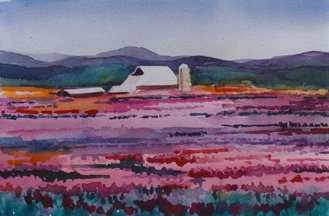
Watercolor is a complex medium – one with many aspects and elements to it. Glazing is the application of a layer of color over one that has already dried. Developing skill in glazing lets you in on the secret of luminous color that is a major characteristic of watercolor.
 This was a course that I taught for quite a few years online, but it was done through the Shutterfly share site and they have taken that down. I thought that for a while I will leave some of the photos and some of the thoughts and hopefully you will discover the glorious luminosity that occurs when glazing in watercolor.
This was a course that I taught for quite a few years online, but it was done through the Shutterfly share site and they have taken that down. I thought that for a while I will leave some of the photos and some of the thoughts and hopefully you will discover the glorious luminosity that occurs when glazing in watercolor.
Glazing is simply putting a layer of color and water down over a layer which has already dried. The viewer mixes the colors in the back of their eye. They see the red and the blue. The cones and rod send signals to the brain where it becomes a purple or a lavender or a mauve.


Graded wash with red across all 4 rectangles.
When dry, the first was glazed with blue, the second with yellow, the third with lavender, and the 4th with yellow. The 4th then had a 3rd glaze of blue after the yellow was dry.
You will work on:
- Wet on wet color harmonics
- Random wet-on-wet color harmonics
- One color per glaze, wet-on-wet
 One color per glaze mist or fog painting
One color per glaze mist or fog painting- One color per glaze simple sunset
- One color per glaze sunset with clouds
- One color per glaze, trying a painting
- Studying your color mixes
- Graded wash glazing
- Glazing with consideration of pigment choice
By the end of the course you will have a much greater understanding of the glazing process.

Wet on wet glazing

Glazing with two graded washes, first blue and then yellow.

Simple glaze paintings
Equipment:
 This is the basic equipment list which I do 95% of my own work. D’ARCHES WATERCOLOR PAPER, cold press, 90 or 140 lb.
This is the basic equipment list which I do 95% of my own work. D’ARCHES WATERCOLOR PAPER, cold press, 90 or 140 lb.
#2 or 2B pencil
white eraser
2 pint or quart sized water containers
a roll of tissue
1″ clear-handled flat brush — such as WINSOR NEWTON or DANIEL SMITH (72-99) BRUSH
#10 pointed round brush — such as ROBERT SIMMONS #10 or Skyflow, white sable 785
LIDDED PALETTE — such as Aqua Pro, or John Pike, or Steve Quiller’s with at least:
•yellow
•red
•blue
• burnt orange or burnt sienna
• a violet
in artist grade watercolor paint such as Daniel Smith, Winsor Newton, Da Vinci, Holbein.
Arrange your paints in a color wheel (ie rainbow).
I use Daniel Smith colors. Assuming you do not want to buy them all, besides the 6 listed above, first consider the hues highlighted in bold.
cobalt green
pthalo green, or Winsor green
cobalt teal blue
cerulean blue
pthalo blue, or Winsor blue
 ultramarine blue
ultramarine blue
cobalt blue
ultramarine violet
quinacridone violet
quinacridone red or perylene red
quinacridone rose
cadmium red medium
Indian red
quinacridone burnt orange (or sienna)
perinone orange
quinacridone gold
cadmium yellow light, or Winsor yellow, or Hansa
aureolin
green gold
Note: you do not want browns, blacks, white. The paper is the white and we mix luscious browns, blacks etc.
OPTIONAL
a large flat brush such as an 1 1/2″ or 2″ or larger.SKYFLOW is good but not necessary.
Hairdryer.
A lightweight board
tape or clips
Caroline
